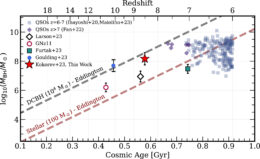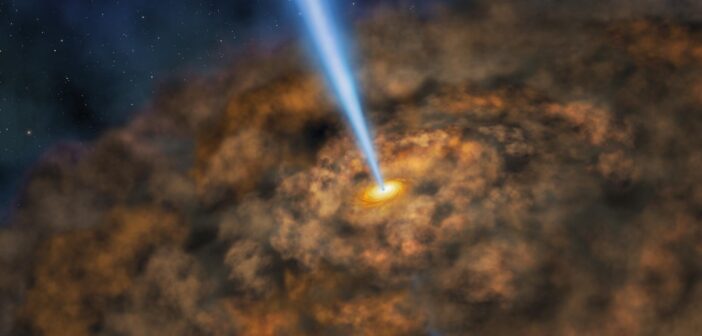JWST has uncovered a population of point-like red objects in the early universe that may be active black holes shrouded in dust. Recent follow-up observations of one of these objects suggest that it’s an active supermassive black hole that’s disproportionately large compared to the galaxy it inhabits.
Supermassive Black Holes in the Making

The collapse of a primordial gas cloud into a black hole is a possible way to make supermassive black hole seeds in the 104–105-solar-mass range. [NASA/CXC/M. Weiss; CC BY 4.0]
Both scenarios have challenges: it’s not clear how stellar-mass black holes could sustain the accretion rate necessary to transform into supermassive black holes, and we don’t yet have direct evidence for the formation of massive black hole seeds. To learn more about how supermassive black holes come to be, researchers need to amass observations of these objects in the early universe.
Red Source Revealed
Vasily Kokorev (Kapteyn Astronomical Institute) and collaborators followed up on observations of a reddish point source made through the JWST Ultradeep NIRSpec and NIRCam ObserVations before the Epoch of Reionization (UNCOVER) program. Spectra of the source, named UNCOVER ID 20466, reveal it to be at a redshift of z = 8.5, placing it about 600 million years after the Big Bang.

Two-dimensional spectrum (top) and one-dimensional extracted spectrum (bottom) of the source investigated in this study. Click to enlarge. [Adapted from Kokorev et al. 2023]
How Large Is the Seed?

Observed black hole masses and ages (symbols) and the black hole masses achievable as a function of time for accretion at the Eddington rate onto a 100-solar-mass seed (red line) and a 104-solar-mass seed (gray line). Click to enlarge. [Kokorev et al. 2023]
Kokorev’s team favors a scenario in which the black hole was seeded by the collapse of a primordial gas cloud into a 104-solar-mass black hole. In this scenario, the black hole can reach its observed mass in the allotted time without surpassing the Eddington limit, the theoretical maximum accretion rate. This also tends to create black holes that are large compared to their host galaxy.
It’s also possible for the black hole’s seed to be smaller, 100 solar masses or so, if it can accrete at super-Eddington rates for hundreds of millions of years — but exactly how that might happen is unclear, especially without the galaxy’s stellar mass growing in tandem. As JWST reveals more of the high-redshift universe, we’ll gain a better understanding of how black hole seeds are sown and sprouted.
Citation
“UNCOVER: A NIRSpec Identification of a Broad-Line AGN at z = 8.50,” Vasily Kokorev et al 2023 ApJL 957 L7. doi:10.3847/2041-8213/ad037a
